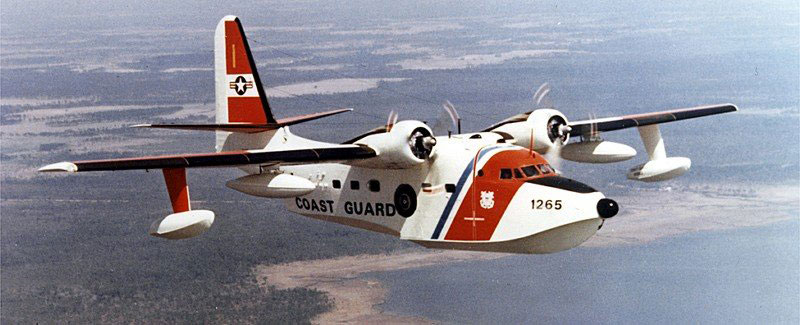
A HU-16 wing fatigue test completed in October of 1968 established a wing service life of 11,000 flight hours. It was realized that normal wear aggravated by operation in a salt laden environment and the steady amassing of flight hours would result in the elimination of the Coast Guard HU-16E fleet of aircraft. During the wing test period, the Coast Guard began exploring replacement options for the HU-16. This resulted in a recommendation to procure a mixed fleet of Sikorsky HH-3F and Lockheed C-130s. As the HH-3F aircraft came on board it became apparent that the mix of aircraft was not a viable operational or financial alternative.
In July of 1971 a Coast Guard Aircraft Characteristics Board was convened to develop operational and performance requirements for Medium Range Search (MRS) aircraft as a replacement for the HU-16E. Concurrently, the Board determined fleet size and geographical distribution. In April of 1972 the Board recommended leasing one representative multi-engine aircraft for mission evaluation in each of the following classifications: turboprop, turbofan, and turbojet.
A Request for Proposal (RFP) resulted in the leasing of a Cessna Citation fanjet and an Israeli J 1123 Westwind turbojet. The RFP did not result in a timely response for a turboprop aircraft so the Coast Guard VC-4A was utilized. The operational evaluation of these aircraft focused on the suitability of each class of aircraft for the range of Coast Guard missions and on establishing a size (weight and volume) baseline for MRS specifications. The evaluation established the viability of the turbofan for multi-mission applications. The turbofan also offered significant reliability when compared to reciprocating engine and turboprop aircraft. The Citation was found to be inadequate in size to perform the Coast Guard’s multi-missions. The Westwind was also found to be lacking in size.
The Aircraft Characteristics Board after reviewing the interim and final evaluation reports and after re-examining the operational requirements determined the MRS aircraft would be powered by fanjet engines, weigh no less than 20,000 pounds with a minimum combined cockpit and cabin interior volume of 600 cubic feet, and have aerial delivery capability.
The three minimum size candidates identified as potential contenders under these requirements were: the Rockwell Sabre 75A,  the French Dassualt Falcon 20, and the British BH-125. The BH-125 was eliminated because the turbo jets that powered it would in low altitude loiter missions impose severe and unacceptable fuel consumption penalties. The Falcon 20 and the Sabre 75A had just completed a head-on FAA procurement competition. Rockwell’s offer significantly under bid that of the Falcon Jet Corporation. The U.S. Military was already using the Saber 75 and rather than proceed with a competitive MRS procurement which would duplicate the FAA effort, the decision was made to proceed with the issuance of a Military Interservice Procurement Request to the U.S. Navy for the purchase of the Sabre 75A.
the French Dassualt Falcon 20, and the British BH-125. The BH-125 was eliminated because the turbo jets that powered it would in low altitude loiter missions impose severe and unacceptable fuel consumption penalties. The Falcon 20 and the Sabre 75A had just completed a head-on FAA procurement competition. Rockwell’s offer significantly under bid that of the Falcon Jet Corporation. The U.S. Military was already using the Saber 75 and rather than proceed with a competitive MRS procurement which would duplicate the FAA effort, the decision was made to proceed with the issuance of a Military Interservice Procurement Request to the U.S. Navy for the purchase of the Sabre 75A.
This decision drew sharp industry and congressional criticism. As a result the Coast Guard went out with a Request for Technical Proposals. It was lengthy and technical and detailed exactly
what the Coast Guard felt was required rather than what was available. Rockwell International, VFW Fokker, Grumman American, Lockheed Marietta, and Falcon Jet Corporation responded. Grumman American withdrew, Rockwell declined to bid, and Falcon Jet Corporation was the low bidder. The award to Falcon Jet Corporation was approved and the HU-25A came into being.

